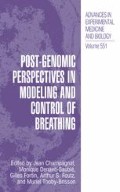Abstract
Sleep apnea is a highly prevalent problem occurring in the general working population at rates of 2–3% in children, 3–7% in middle-aged adults and 10–15% in the healthy elderly (>65 years old).1,2 While anatomical dimensions or mechanical properties of the upper airway are an important risk factor for sleep apnea, neural control over the magnitude and stability of respiratory motor output to both the upper airway and chest wall pump muscles has also emerged as a major contributor to all types of sleep apnea.3–7 Chemoreflexes are the most important determinant of respiratory drive during sleep. Given the rapidity with which hypopneas/apneas develop in a typical central and/or “mixed” apnea episode, our recent work has addressed the general hypothesis that carotid chemoreceptors have a dominant role in mediating ventilatory responses to transient increases and decreases in CO2 as commonly occurs in sleep-disordered breathing.
Access this chapter
Tax calculation will be finalised at checkout
Purchases are for personal use only
Preview
Unable to display preview. Download preview PDF.
References
T. Young, M. Palta, J. Dempsey, J. Skatrud, S. Weber, and S. Badr. The occurrence of sleep-disordered breathing among middle-aged adults. N Engl J Med 328: 1230–1235 (1993).
T. Young, P. E. Peppard, and D. J. Gottlieb. Epidemiology of obstructive sleep apnea: a population health perspective. Am J Respir Crit Care Med 165: 1217–1239 (2002).
M. Younes, M. Ostrowski, W. Thompson, C. Leslie, and W. Shewchuk. Chemical control stability in patients with obstructive sleep apnea. Am J Respir Crit Can Med 163: 1181–1190 (2001).
G. Warner, J. B. Skatrud, and J. A. Dempsey. Effect of hypoxia-induced periodic breathing on upper airway obstruction during sleep. J Appl Physiol 62: 2201–2211 (1987).
J. A. Dempsey, J. B. Skatrud, A. J. Jacques, S. J. Ewanowski, B. T. Woodson, P. R. Hanson, and B. Goodman. Anatomic determinants of sleep-disordered breathing across the spectrum of clinical and nonclinical male subjects. Chest 122: 1–13 (2002).
M. S. Badr, F. Toiber, J. B. Skatrud, and J. Dempsey. Pharyngeal narrowing/occlusion during central sleep apnea. J Appl Physiol 78: 1806–1815 (1995).
M. Younes. Contributions of upper airway mechanics and control mechanisms to severity of obstructive apnea. Am J Respir Crit Care Med 168: 645–658 (2003).
H. Nakayama, C. A. Smith, J. R. Rodman, J. B. Skatrud, and J. A. Dempsey. Effect of ventilatory drive on CO2 sensitivity below eupnea during sleep. Am J Respir Crit Care Med 165: 1251–1259 (2002).
H. Nakayama, C. A. Smith, J. R. Rodman, J. B. Skatrud, and J. A. Dempsey. Carotid body denervation eliminates apnea in response to transient hypocapnia. J. Appl. Physiol. 94: 155–164 (2003).
C. A. Smith, K. W. Saupe, K. S. Henderson, and J. A. Dempsey. Ventilatory effects of specific carotid body hypocapnia in dogs during wakefulness and sleep. J Appl Physiol 79: 689–699 (1995).
C. A. Smith, C. A. Harms, K. S. Henderson, and J. A. Dempsey. Ventilatory effects of specific carotid body hypocapnia and hypoxia in awake dogs. J Appl Physiol 82: 791–798 (1997).
H. Ogawa, A. Mizusawa, Y. Kikuchi, W. Hida, H. Miki, and K. Shirato. Nitric oxide as a retrograde messenger in the nucleus tractus solitarii of rats during hypoxia. J. Physiol. 486: 495–504 (1995).
A. Liu, J. Kim, J. Cinotte, P. Homolka, and M. T. T. Wong-Riley. Carotid body denervation effect on cytochrome oxidase activity in pre-Botzinger complex of developing rats. J. Appl. Physiol. 94: 1115–1121 (2003).
A. Serra, D. Brozoski, N. Hedin, R. Franciosi, and H. V. Forster. Mortality after carotid body denervation in rats. J Appl Physiol 91: 1298–1306 (2001).
Author information
Authors and Affiliations
Editor information
Editors and Affiliations
Rights and permissions
Copyright information
© 2004 Kluwer Academic/Plenum Publishers, New York
About this paper
Cite this paper
Smith, C.A., Chenuel, B.J., Nakayama, H., Dempsey, J.A. (2004). Ventilatory Responsiveness to CO2 Above & Below Eupnea: Relative Importance of Peripheral Chemoreception. In: Champagnat, J., Denavit-Saubié, M., Fortin, G., Foutz, A.S., Thoby-Brisson, M. (eds) Post-Genomic Perspectives in Modeling and Control of Breathing. Advances in Experimental Medicine and Biology, vol 551. Springer, Boston, MA. https://doi.org/10.1007/0-387-27023-X_11
Download citation
DOI: https://doi.org/10.1007/0-387-27023-X_11
Publisher Name: Springer, Boston, MA
Print ISBN: 978-0-306-48507-7
Online ISBN: 978-0-387-27023-4
eBook Packages: Biomedical and Life SciencesBiomedical and Life Sciences (R0)

